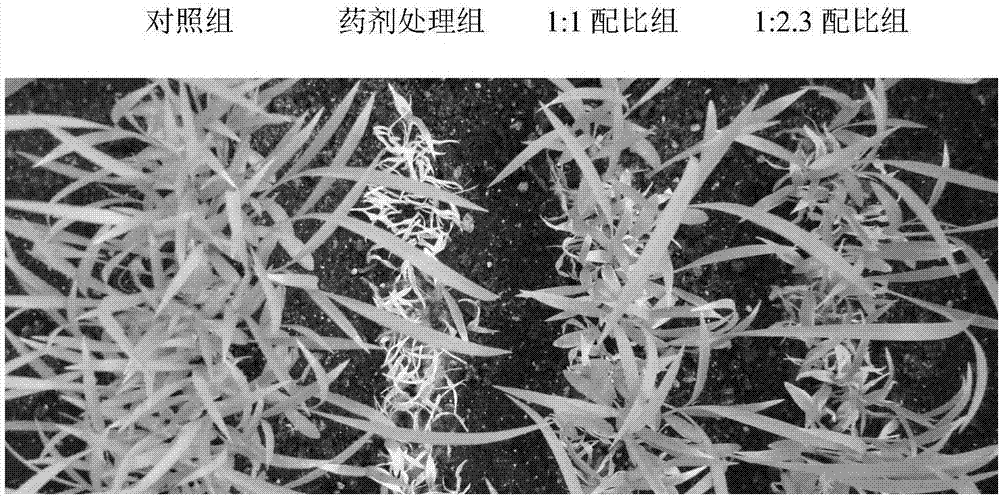Setaria italica chemically-controlled seedling thinning method
A technology free of thinning and millet, applied in the fields of seed and rhizome treatment, application, agriculture, etc., which can solve the problems of cumbersome artificial thinning
- Summary
- Abstract
- Description
- Claims
- Application Information
AI Technical Summary
Problems solved by technology
Method used
Image
Examples
Embodiment 1
[0020] Using the local millet variety "Changnong 44" as the material, the full grain seeds were screened and weighed, and two grain seeds with the same quality were taken, one for drug treatment and one for control;
[0021] Add 3.6‰ clomazone medicament according to the ratio of medicament volume to grain seed mass ratio of 8.3:10 (L / kg), soak at 28°C for 1 hour, and replace clomazone medicament with equal volume of distilled water for control;
[0022] The grain seeds are fished out, air-dried, and sown.
[0023] Results: There was no significant difference between the emergence rate of the medicine-soaking group and the control group, both reached more than 90%, but the leaves of the millet seedlings in the medicine-soaking group were albino leaves; the leaves of the seedlings of the medicine-soaking group grew wilting after 7 days of growth, and the seedlings gradually died after 12 days. During the same period, millet seedlings in the control group grew well.
Embodiment 2
[0025] Using the local millet variety "Changnong 44" as the material, the full grain seeds were screened and weighed, and two grain seeds with the same quality were taken, one for drug treatment and one for control;
[0026] Add 0.72‰ clomazone medicament according to the proportion of medicament volume and grain seed mass ratio of 8.3:10 (L / kg), soak at 28°C for 5 hours, and replace the clomazone medicament with equal volume of distilled water for control;
[0027] The grain seeds are fished out, air-dried, and sown.
[0028] Results: There was no significant difference between the emergence rate of the medicine-soaking group and the control group, both reached more than 90%, but the leaves of the millet seedlings in the medicine-soaking group were albino leaves; the leaves of the seedlings of the medicine-soaking group were wilting after 8 days of growth, and the seedlings gradually died after 14 days. During the same period, millet seedlings in the control group grew well. ...
Embodiment 3
[0030] Using the local millet varieties "Changnong 44", "Taixuan 15" and "Changnong 35" as materials, the full grain seeds were screened and weighed. Three grains with the same quality were taken for each variety, and one was used as a control. Two copies are used for drug treatment.
[0031] The two grain seeds in the drug treatment group were added with 1.2‰ and 1.4‰ of clomazone at a ratio of 8.3:10 (L / kg) by volume and mass of grain seeds, and soaked at 28°C for 3 hours. volume of distilled water instead of clomazone;
[0032] The grain seeds are fished out, air-dried, and sown.
[0033] The statistics of the results are shown in Table 1.
[0034] The calculation formulas of seedling emergence rate (%) and seedling retention rate (%) are as follows:
[0035] Emergence rate (%) = total number of seedlings / total number of sowing
[0036] Seedling retention rate (%) = total number of seedlings retained / total number of emergence
[0037] Table 1 After soaking clomazone,...
PUM
 Login to View More
Login to View More Abstract
Description
Claims
Application Information
 Login to View More
Login to View More - R&D
- Intellectual Property
- Life Sciences
- Materials
- Tech Scout
- Unparalleled Data Quality
- Higher Quality Content
- 60% Fewer Hallucinations
Browse by: Latest US Patents, China's latest patents, Technical Efficacy Thesaurus, Application Domain, Technology Topic, Popular Technical Reports.
© 2025 PatSnap. All rights reserved.Legal|Privacy policy|Modern Slavery Act Transparency Statement|Sitemap|About US| Contact US: help@patsnap.com



